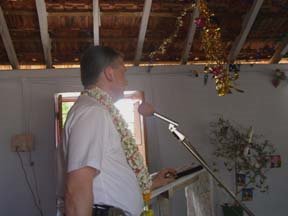 Among the many monuments and shrines we saw as we traveled in Andhra Pradesh and Tamil Nadu, I recall a statue of a hooded cobra. We were told that the people who live near that particular place worship the snake. Can you imagine worshiping a snake? I read in one place that in
Among the many monuments and shrines we saw as we traveled in Andhra Pradesh and Tamil Nadu, I recall a statue of a hooded cobra. We were told that the people who live near that particular place worship the snake. Can you imagine worshiping a snake? I read in one place that in But Indians are not the first to worship the snake. Questalcoatl, the mythical " Plumb Serpent" was worshipped as the "master of life" by ancient Aztecs of Central America. Some African cultures worshipped the rock python and consider the killing of one to be serious crime. In
In Numbers 21 the fiery serpents symbolize sin. Sin is that which poisons our lives. Sin, like the fiery serpents, enflames us with lust and passion, greed and anger. Sin brings great pain into our lives when its venom has had time to work its work of ruin. And sin, in the end, brings death.
It is a curious thing that God should use the symbol of a snake, the means of affliction, lifted up as a means of cure, and that Jesus should make Himself the New Testament counterpart of it with the words, “as Moses lifted up the serpent in the wilderness, even so must the Son of man be lifted up: That whosoever believeth in him should not perish, but have eternal life.” (John 3:14-15) Why should the holy and righteous Son of God be symbolized by His arch-enemy? If the snake is a type or a symbol for sin, how is that a counterpart of Jesus, when Jesus is the sinless one?
2 Corinthians 5:21 answers the question, and communicates life and hope to our hearts when it says, “For he hath made him to be sin for us, who knew no sin; that we might be made the righteousness of God in him.”
We wonder how a symbol for sin could be a symbol for Christ, until we realize that when Jesus was lifted up on the cross, He was lifted up as the sin-bearer. Isaiah said of Him, “The Lord hath laid on Him the iniquity of us all.”
Everything about us that is sinful, evil, of such horrible character as could be represented by such a symbol as a serpent – that is what was laid upon the Son of God, and was borne by him as He was lifted up on the cross. Though He was the innocent One, the perfect Lamb of God, who knew no sin, He, Paul says, “became sin” for us, and when He was lifted up on the cross, it was our sin that was lifted there.
Like the Israelites who were to look up at the snake, we, too, need to look and see this awesome truth: Indeed, this blessed truth. And when we look, what do we see?
We see our sin, nailed to the cross. We see our sin, receiving its just due. We see our sin being stamped “Paid in Full”, and so we see the obligation to suffer the penalty for it being lifted from us, because it was placed upon Christ instead.
When we look and see that this is the way it really is, we live. We live, because it sets us free. It tells us that the curse was taken from us. That the punishment has already been suffered. That the debt has already been paid. It is DONE. FINISHED. Can’t add to it, can’t subtract from it. Can’t improve upon it, can’t undo it.
The devil can come and rag on us in all kinds of ways, and everything he says about us might be true. When we look at ourselves, we will see all kinds of imperfections, all kinds of weaknesses, all kinds of reasons why we are disqualified, guilty, unworthy, hopeless. What can we do but agree that this is true?
But if the devil also wants us to agree that for all this we might as well give up hope, we must say, “NO! That’s where you are wrong! Even though all this is true about me, it is all of this that was laid upon Christ, and it is all of this that was taken to the cross.”
Yes, the devil can find fault with us, but he can’t touch Christ. He can’t do a thing about what has already been done. So it is upon Christ that we need to look. And when we look away to Christ, and see that the issue has been settled forever, that our sin has been punished, and all of Christ’s perfections are made ours, then we are free. Then we can rejoice, and then we can turn our attention away from, “What am I going to do about me?” to “How can I serve Christ in gratitude for what He has done for
We need to look to Jesus every day. It is easy to get our eyes off from Him and begin to look again to ourselves, as if something relating to our salvation depends upon us.
But every time we begin to think there is something we need to correct or fix before we can rejoice in Christ, we lose our peace, and become crippled in our service to Him.
Once in a while God might want us to look at ourselves, so that we see how hopeless and helpless we are, but His purpose is to renew our motivation to look to Jesus instead of ourselves.
The devil wants us to look at ourselves in order to depress us, but God wants to draw us to Jesus.

